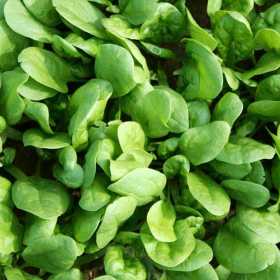How to Grow Spinach – A Guide to Growing Spinach
 Spinach
Spinach
True spinach is a bit more demanding to grow in its need for cooler weather than perpetual spinach but its taste is superior. The gardener can grow it as a main crop or pick it young for use as baby salad leaves. Spinach grows well in containers or even in small patches in the flower border,where the shade from other plants will help keep it cooler.
Recommended Varieties of Spinach
- Tetona F1 Hybrid – A very productive variety producing bright green, smooth, rounded leaves available for picking over a long period. Slow to bolt, and ideal baby leaves for salads. Tetona also features excellent downy mildew resistance, especially important for spring and autumn sowings. Awarded RHS AGM
- F1 Amazon Seed – A fast-growing true type spinach which has attractive round, dark green foliage which is delicious as baby leaves. Ideal for spring and autumn growing: it is possible to sow from as early as February and as late as September, though recommended times are March to mid April and August. Mildew resistant. UK bred. Awarded RHS AGM
- F1 MIkado – A unique bolt-resistant oriental spinach which can be sown all summer as well as in spring and autumn. It has excellent downy mildew resistance and produces masses of delicious, dark green, pointed leaves with pink tips to the stem bases.
Spinach Pests And Problems
- A cool weather crop, spinach tends to bolt and run to seed easily in summer. Nor will it germinate in hot summer weather.
- Mildew can be a problem as can rabbits.
Sowing and Growing Spinach
- There are two main types – summer and winter. Summer spinach prefers cooler spring or later fall weather and ideally tucked in the shade of a crop of tall peas or sweetcorn. Both types need a rich soil with generous amounts of nitrogen to encourage growth, and lots of water.
- Spinach grows easily from direct seeding: summer spinach weekly in April–May, and winter spinach in August–September to maintain a steady supply of tender leaves
- Sow thinly 2–3 cm (1 inch) deep, in rows 30 cm (12 inches) apart.
- Thin to 10 cm (4 inches) between plants when the first leaves appear. Thinnings can be eaten.
- Spinach can also be started in modules or containers. Sow every two weeks through April and May. Thin out to one plant per module, and plant out at about 30 cm (1 foot) apart. Container plants can be more closely grown.
- Keep weed free and soil consistently moist.
Harvesting, Eating and Storing Spinach
Once directly sown spinach has developed a little, remove every other plant and use in the kitchen, leaving the others to grow on.
To extend harvest, pick young leaves from the outside of the plants as needed. With summer spinach you can take as much as half the leaves in one go, but winter spinach is slower to grow so take only a few leaves from each plant to extend the harvest.
Ideally, spinach is best eaten fresh but it can also be frozen. Rinse leaves very thoroughly several times, blanch for 2 minutes in boiling, unsalted water, drain and press dry. A salad spinner is ideal. Pack dried leaves in required serving sizes in freezer bags, press out air and seal.
Use the fresh leaves as soon as they’re picked as spinach does not store well. Fresh, bright, vibrant-looking spinach leaves are not only more visually appealing but are also more nourishing. For cooking, pick more than you think you need as the leaves will reduce to quite a small amount in the pan.
Spinach is rich in vitamins and minerals but sadly not as much iron as Popeye would have you believe!



